display Lancia Ypsilon 2011 Owner handbook (in English)
[x] Cancel search | Manufacturer: LANCIA, Model Year: 2011, Model line: Ypsilon, Model: Lancia Ypsilon 2011Pages: 299, PDF Size: 13.35 MB
Page 80 of 299
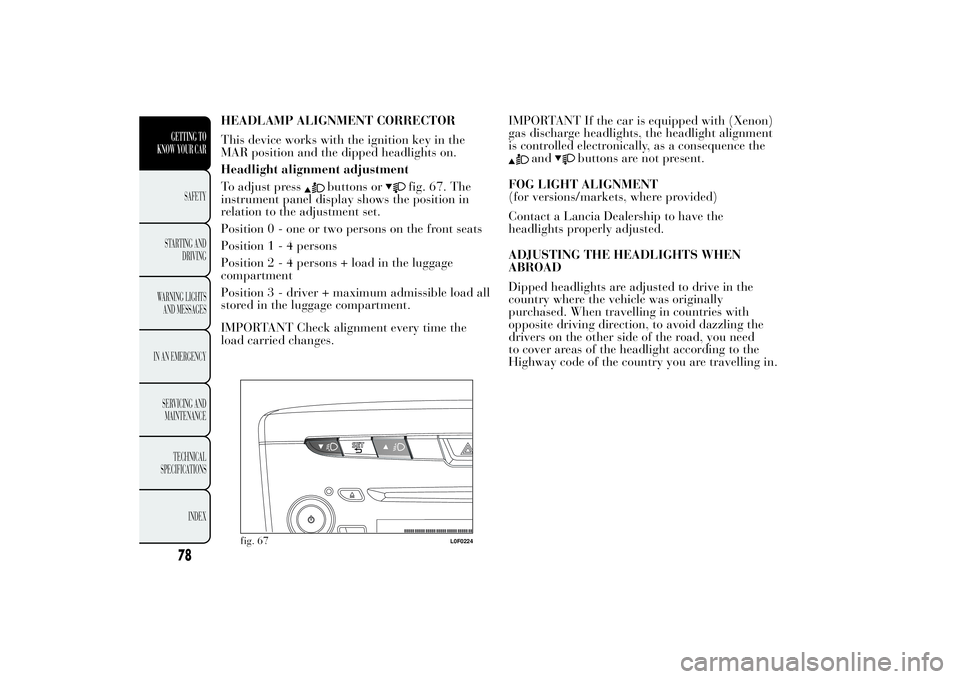
HEADLAMP ALIGNMENT CORRECTOR
This device works with the ignition key in the
MAR position and the dipped headlights on.
Headlight alignment adjustment
To adjust press
buttons or
fig. 67. The
instrument panel display shows the position in
relation to the adjustment set.
Position 0 - one or two persons on the front seats
Position1-4persons
Position2-4persons + load in the luggage
compartment
Position 3 - driver + maximum admissible load all
stored in the luggage compartment.
IMPORTANT Check alignment every time the
load carried changes.IMPORTANT If the car is equipped with (Xenon)
gas discharge headlights, the headlight alignment
is controlled electronically, as a consequence the
and
buttons are not present.
FOG LIGHT ALIGNMENT
(for versions/markets, where provided)
Contact a Lancia Dealership to have the
headlights properly adjusted.
ADJUSTING THE HEADLIGHTS WHEN
ABROAD
Dipped headlights are adjusted to drive in the
country where the vehicle was originally
purchased. When travelling in countries with
opposite driving direction, to avoid dazzling the
drivers on the other side of the road, you need
to cover areas of the headlight according to the
Highway code of the country you are travelling in.
fig. 67
L0F0224
78GETTING TO
KNOW YOUR CAR
SAFETY
STARTING
AND
DRIVING
WARNING LIGHTS
AND MESSAGES
IN AN EMERGENCY
SERVICING AND
MAINTENANCE
TECHNICAL
SPECIFICATIONS
INDEX
Page 83 of 299
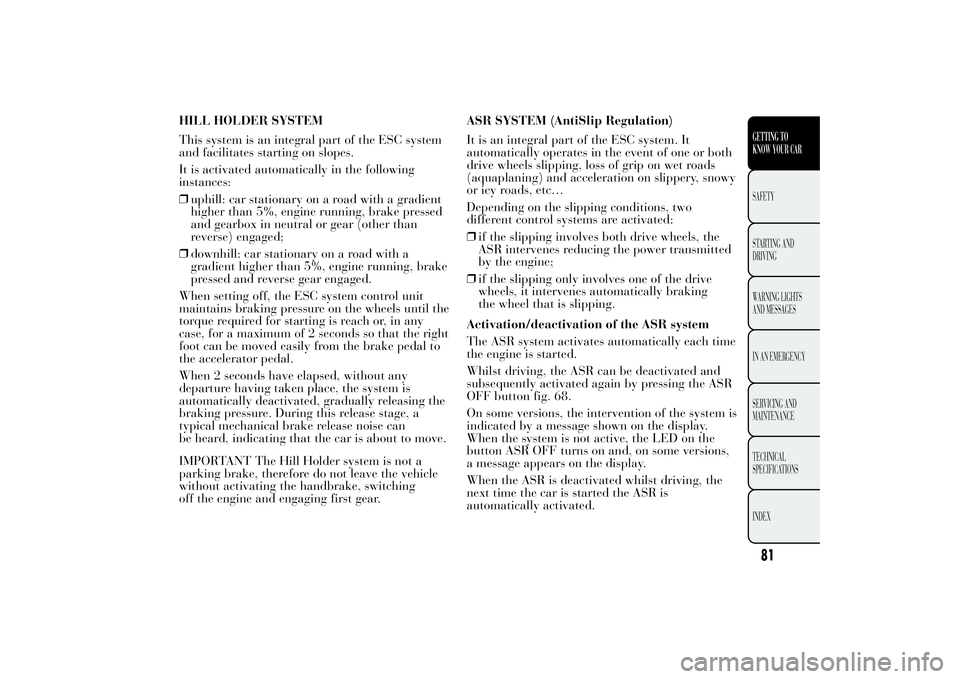
HILL HOLDER SYSTEM
This system is an integral part of the ESC system
and facilitates starting on slopes.
It is activated automatically in the following
instances:
❒uphill: car stationary on a road with a gradient
higher than 5%, engine running, brake pressed
and gearbox in neutral or gear (other than
reverse) engaged;
❒downhill: car stationary on a road with a
gradient higher than 5%, engine running, brake
pressed and reverse gear engaged.
When setting off, the ESC system control unit
maintains braking pressure on the wheels until the
torque required for starting is reach or, in any
case, for a maximum of 2 seconds so that the right
foot can be moved easily from the brake pedal to
the accelerator pedal.
When 2 seconds have elapsed, without any
departure having taken place, the system is
automatically deactivated, gradually releasing the
braking pressure. During this release stage, a
typical mechanical brake release noise can
be heard, indicating that the car is about to move.
IMPORTANT The Hill Holder system is not a
parking brake, therefore do not leave the vehicle
without activating the handbrake, switching
off the engine and engaging first gear.ASR SYSTEM (AntiSlip Regulation)
It is an integral part of the ESC system. It
automatically operates in the event of one or both
drive wheels slipping, loss of grip on wet roads
(aquaplaning) and acceleration on slippery, snowy
or icy roads, etc…
Depending on the slipping conditions, two
different control systems are activated:
❒if the slipping involves both drive wheels, the
ASR intervenes reducing the power transmitted
by the engine;
❒if the slipping only involves one of the drive
wheels, it intervenes automatically braking
the wheel that is slipping.
Activation/deactivation of the ASR system
The ASR system activates automatically each time
the engine is started.
Whilst driving, the ASR can be deactivated and
subsequently activated again by pressing the ASR
OFF button fig. 68.
On some versions, the intervention of the system is
indicated by a message shown on the display.
When the system is not active, the LED on the
button ASR OFF turns on and, on some versions,
a message appears on the display.
When the ASR is deactivated whilst driving, the
next time the car is started the ASR is
automatically activated.
81GETTING TO
KNOW YOUR CARSAFETY
STARTING
AND
DRIVING
WARNING LIGHTS
AND MESSAGES
IN AN EMERGENCY
SERVICING AND
MAINTENANCE
TECHNICAL
SPECIFICATIONS
INDEX
Page 85 of 299

MSR SYSTEM
(Motor Schleppmoment Regelung)
This system is an integral part of the ABS, that
intervenes, if there is sudden downshifting,
restoring torque to the engine, thereby preventing
excessive drive at the drive wheels which,
especially in poor grip conditions, could lead to a
loss in stability of the car.
START&STOP SYSTEMINTRODUCTION
The Start&Stop system automatically stops the
engine each time the car is stationary and starts it
again when the driver wants to move off. In this
way, the car efficiency is increased, by reducing
consumption, dangerous gas emissions and noise
pollution.
The system activates every time the car is started.
OPERATING MODES
Engine stopping mode
With the car stopped, the engine stops with
gearbox in neutral and clutch pedal released.
NoteThe engine can only be stopped
automatically after driving at a speed of more
than about 10 km/h, to prevent the engine from
being repeatedly stopped when driving at walking
pace.
Symbol
appears on the display when the engine
stops.
83GETTING TO
KNOW YOUR CARSAFETY
STARTING
AND
DRIVING
WARNING LIGHTS
AND MESSAGES
IN AN EMERGENCY
SERVICING AND
MAINTENANCE
TECHNICAL
SPECIFICATIONS
INDEX
Page 86 of 299

Engine t mode
Press the clutch pedal to restart the engine.
MANUAL SYSTEM ACTIVATION/
DEACTIVATION
To activate/deactivate the system manually, press
the button
fig. 69 on the dashboard control
trim.
Start&Stop system activation
Start&Stop system activation is signalled by a
message on the display. In this condition, the LED
on the button
is off.
Start&Stop system deactivation
Versions with multifunction display: a message
appears on the display when the Start&Stop
system is deactivated.Versions with reconfigurable multifunction
display: the
symbol and a message appear on
the display when the Start&Stop system is
deactivated.
The LED above the
button is on when the
system is deactivated.
ENGINE STOPPING FAILURE CONDITIONS
When the system is active, due to comfort,
emission control and safety reasons, the engine
does not stop in some conditions, among which:
❒engine still cold;
❒especially cold outside temperature;
❒battery not sufficiently charged;
❒heated rear window activated;
❒windscreen wipers working at maximum speed;
❒particulate filter regeneration (DPF) in progress
(diesel engines only);
❒driver's door not shut;
❒driver's seat belt not fastened;
❒reverse gear engaged (for example, for parking
manoeuvres);
❒for versions equipped with automatic climate
control (for versions/markets, where provided),
if an adequate level of thermal comfort has
not been reached or with MAX-DEF activation;
❒during the first period of use, to initialise the
system.
fig. 69
L0F0044
84GETTING TO
KNOW YOUR CAR
SAFETY
STARTING
AND
DRIVING
WARNING LIGHTS
AND MESSAGES
IN AN EMERGENCY
SERVICING AND
MAINTENANCE
TECHNICAL
SPECIFICATIONS
INDEX
res arting
Page 87 of 299

In these cases, the display shows a message and -
for versions/markets, where provided - the symbol
flashes on the display.
If climate comfort is to be favoured, the
Start&Stop system can be disabled,
for a continuous operation of the
climate control system.
ENGINE RESTARTING CONDITIONS
For reasons of comfort, limiting harmful emissions
and safety purposes, the power unit can restart
automatically without any action on behalf of the
driver if certain conditions are met, including:
❒battery not sufficiently charged;
❒windscreen wipers working at maximum speed;
❒reduced braking system vacuum (e.g. if the
brake pedal is pressed repeatedly);
❒car moving (e.g. when driving on roads with a
gradient);
❒engine stopping by Start&Stop system for over
3 minutes;
❒for versions equipped with automatic climate
control (for versions/markets where provided),
to enable suitable thermal comfort or with
MAX-DEF activation.With gear engaged, automatic engine restarting is
possible only by fully depressing the clutch pedal.
The driver is informed by the displaying of a
message on the display and - for versions/markets,
where provided - by the flashing of the symbol
.
Notes
If the clutch is not pressed, 3 minutes after the
engine stops, the engine can be restarted only
using the ignition key.
In cases when the engine stops and this is not
desired, due for example to the clutch pedal being
released sharply with a gear engaged, if the
Start&Stop system is activated, the engine can be
restarted by fully depressing the clutch pedal or
by placing the gear lever in neutral.
SAFETY FUNCTIONS
When the engine is stopped by the Start&Stop
system, if the driver releases his/her seat belt and
opens the driver's or passenger's door, the engine
can be restarted only using the ignition key.
The driver is informed by a buzzer and by the
flashing of the symbol
on the display; on some
versions, a message is displayed as well.
85GETTING TO
KNOW YOUR CARSAFETY
STARTING
AND
DRIVING
WARNING LIGHTS
AND MESSAGES
IN AN EMERGENCY
SERVICING AND
MAINTENANCE
TECHNICAL
SPECIFICATIONS
INDEX
Page 88 of 299
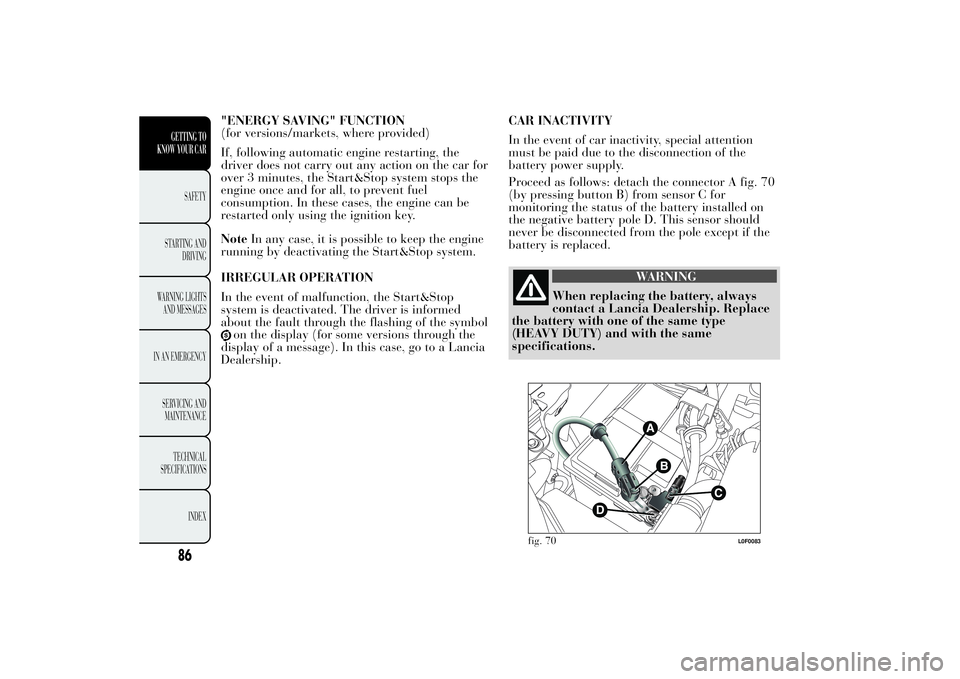
"ENERGY SAVING" FUNCTION
(for versions/markets, where provided)
If, following automatic engine restarting, the
driver does not carry out any action on the car for
over 3 minutes, the Start&Stop system stops the
engine once and for all, to prevent fuel
consumption. In these cases, the engine can be
restarted only using the ignition key.
NoteIn any case, it is possible to keep the engine
running by deactivating the Start&Stop system.
IRREGULAR OPERATION
In the event of malfunction, the Start&Stop
system is deactivated. The driver is informed
about the fault through the flashing of the symbol
on the display (for some versions through the
display of a message). In this case, go to a Lancia
Dealership.CAR INACTIVITY
In the event of car inactivity, special attention
must be paid due to the disconnection of the
battery power supply.
Proceed as follows: detach the connector A fig. 70
(by pressing button B) from sensor C for
monitoring the status of the battery installed on
the negative battery pole D. This sensor should
never be disconnected from the pole except if the
battery is replaced.
WARNING
When replacing the battery, always
contact a Lancia
Dealership. Replace
the battery with one of the same type
(HEAVY DUTY) and with the same
specifications.
fig. 70
L0F0083
86GETTING TO
KNOW YOUR CAR
SAFETY
STARTING
AND
DRIVING
WARNING LIGHTS
AND MESSAGES
IN AN EMERGENCY
SERVICING AND
MAINTENANCE
TECHNICAL
SPECIFICATIONS
INDEX
Page 90 of 299

EOBD SYSTEMThe EOBD system (European On Board
Diagnosis) carries out a continuous diagnosis of
the components of the car related to emissions. It
also alerts the driver about component
deterioration by switching on the warning light on
the instrument panel and the displaying of a
relevant message (for versions/markets, where
provided) (see the chapter “Warning lights and
messages”).
The aim of the EOBD system (European On Board
Diagnosis) is to:
❒monitor the system efficiency;
❒indicate an increase in emissions;
❒indicate the need to replace damaged
components.
The system also has a diagnosis connector that
can be interfaced to suitable instruments, to read
the error codes stored in the control unit together
with a series of specific parameters for engine
operation and diagnosis.
IMPORTANT After eliminating the failure, to
check the system completely, Lancia Dealerships
run a bench test and, if necessary, road tests which
may also call for a long journey.
DUALDRIVE ELECTRIC POWER
STEERINGThis only operates with the key turned to MAR
and the engine started. The steering allows the
force required at the steering wheel to be adjusted
to suit driving conditions.
IMPORTANT When turning the ignition key
quickly, full power steering functionality can be
achieved after a few seconds.
CITY FUNCTION ACTIVATION/
DEACTIVATION
Press button CITY fig. 73 to activate/deactivate
the function. The activation of the function is
signalled by the word CITY on the display (in
some versions it is signalled by the word CITY
appearing on the instrument panel).
fig. 73
L0F0082
88GETTING TO
KNOW YOUR CAR
SAFETY
STARTING
AND
DRIVING
WARNING LIGHTS
AND MESSAGES
IN AN EMERGENCY
SERVICING AND
MAINTENANCE
TECHNICAL
SPECIFICATIONS
INDEX
Page 95 of 299
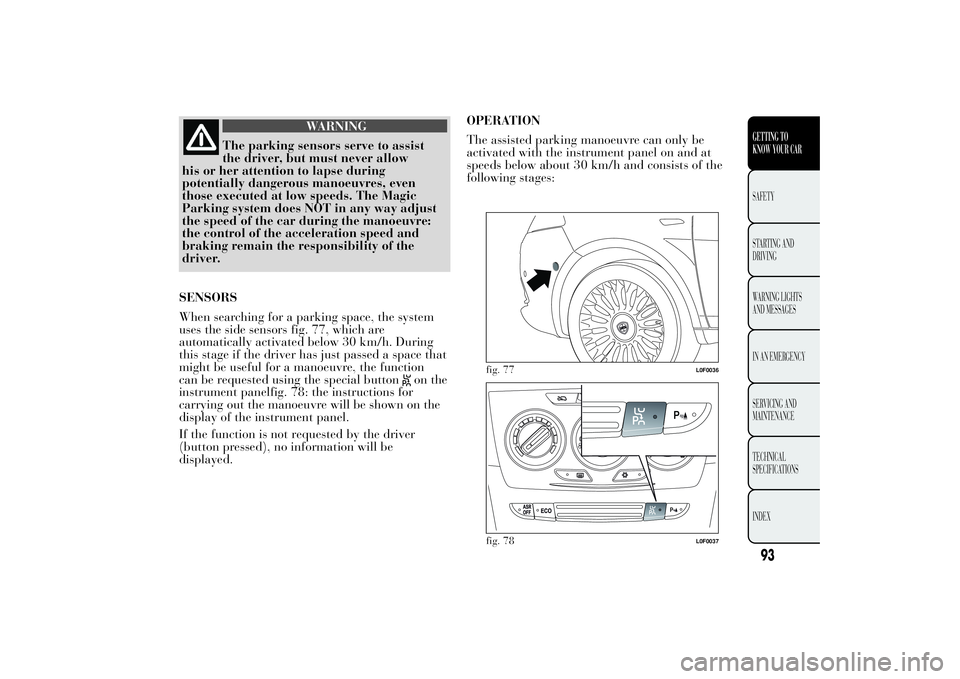
WARNING
The parking sensors serve to assist
the driver,
but must never allow
his or her attention to lapse during
potentially dangerous manoeuvres, even
those executed at low speeds. The Magic
Parking system does NOT in any way adjust
the speed of the car during the manoeuvre:
the control of the acceleration speed and
braking remain the responsibility of the
driver.
SENSORS
When searching for a parking space, the system
uses the side sensors fig. 77, which are
automatically activated below 30 km/h. During
this stage if the driver has just passed a space that
might be useful for a manoeuvre, the function
can be requested using the special button
on the
instrument panelfig. 78: the instructions for
carrying out the manoeuvre will be shown on the
display of the instrument panel.
If the function is not requested by the driver
(button pressed), no information will be
displayed.OPERATION
The assisted parking manoeuvre can only be
activated with the instrument panel on and at
speeds below about 30 km/h and consists of the
following stages:
fig. 77
L0F0036
fig. 78
L0F0037
93GETTING TO
KNOW YOUR CARSAFETY
STARTING
AND
DRIVING
WARNING LIGHTS
AND MESSAGES
IN AN EMERGENCY
SERVICING AND
MAINTENANCE
TECHNICAL
SPECIFICATIONS
INDEX
Page 96 of 299
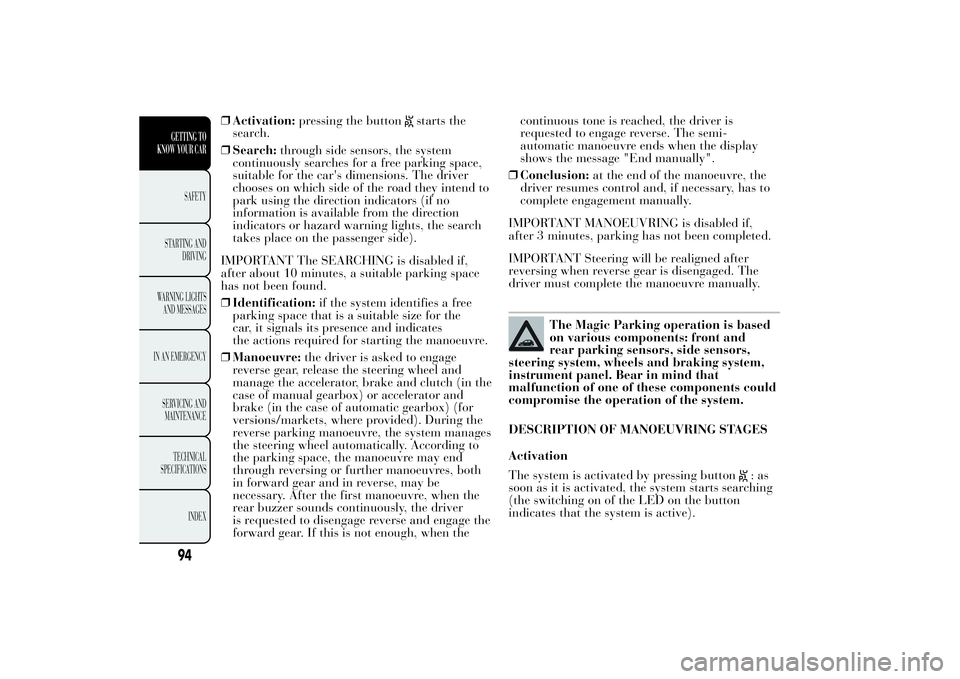
❒Activation:pressing the button
starts the
search.
❒Search:through side sensors, the system
continuously searches for a free parking space,
suitable for the car's dimensions. The driver
chooses on which side of the road they intend to
park using the direction indicators (if no
information is available from the direction
indicators or hazard warning lights, the search
takes place on the passenger side).
IMPORTANT The SEARCHING is disabled if,
after about 10 minutes, a suitable parking space
has not been found.
❒Identification:if the system identifies a free
parking space that is a suitable size for the
car, it signals its presence and indicates
the actions required for starting the manoeuvre.
❒Manoeuvre:the driver is asked to engage
reverse gear, release the steering wheel and
manage the accelerator, brake and clutch (in the
case of manual gearbox) or accelerator and
brake (in the case of automatic gearbox) (for
versions/markets, where provided). During the
reverse parking manoeuvre, the system manages
the steering wheel automatically. According to
the parking space, the manoeuvre may end
through reversing or further manoeuvres, both
in forward gear and in reverse, may be
necessary. After the first manoeuvre, when the
rear buzzer sounds continuously, the driver
is requested to disengage reverse and engage the
forward gear. If this is not enough, when thecontinuous tone is reached, the driver is
requested to engage reverse. The semi-
automatic manoeuvre ends when the display
shows the message "End manually".
❒Conclusion:at the end of the manoeuvre, the
driver resumes control and, if necessary, has to
complete engagement manually.
IMPORTANT MANOEUVRING is disabled if,
after 3 minutes, parking has not been completed.
IMPORTANT Steering will be realigned after
reversing when reverse gear is disengaged. The
driver must complete the manoeuvre manually.
The Magic Parking operation is based
on various components: front and
rear parking sensors, side sensors,
steering system, wheels and braking system,
instrument panel. Bear in mind that
malfunction of one of these components could
compromise the operation of the system.
DESCRIPTION OF MANOEUVRING STAGES
Activation
The system is activated by pressing button
:as
soon as it is activated, the system starts searching
(the switching on of the LED on the button
indicates that the system is active).
94GETTING TO
KNOW YOUR CAR
SAFETY
STARTING
AND
DRIVING
WARNING LIGHTS
AND MESSAGES
IN AN EMERGENCY
SERVICING AND
MAINTENANCE
TECHNICAL
SPECIFICATIONS
INDEX
Page 97 of 299

Since the system recognises parking spaces even
when it is deactivated, the system can be activated
straight away after having driven past an
adjacent parking space that is deemed suitable.
If the system has effectively identified a parking
space, searching will not be performed and the
system will notify the driver of the operations
required to carry out the manoeuvre correctly
through the instrument panel display .
Search for a parking space
While searching fig. 79 the car should continue
following its route at a speed of below 30 km/h
and at a distance of around 50 cm to 130 cm from
parked cars. A parking space is considered
suitable if it is about 80 cm longer than the
dimensions of the car.
Selection of search side and carrying out
manoeuvre
To select the search side and carry out the
manoeuvre, proceed as follows:1)
Choose to carry out the search for the space
and the manoeuvre on the passenger side with:
❒direction indicator in middle position;
❒hazard warning lights on;
❒hazard warning lights on and direction indicator
in passenger side position;
❒direction indicator activated in passenger side
position.
2)Choose to carry out the search for the space
and the manoeuvre on the driver's side with:
❒direction indicator activated in driver's side
position;
❒hazard warning lights on and direction indicator
in driver's side position.
The system will notify the driver of the side on
which the search and the manoeuvre will take
place by displaying messages and switching on the
or
warning lights on the instrument panel.
Searching occurs on both sides of the road:
therefore the selection can be made through the
direction indicators even after having passed
a suitable parking place.
IMPORTANT While searching, speed should not
exceed 30 km/h; when 25 km/h has been reached,
the driver is asked to decrease the speed; if the
speed of 30/h is exceeded, the system is disabled;
in this case, the system must be restarted by
pressing button
).
fig. 79
L0F1001
95GETTING TO
KNOW YOUR CARSAFETY
STARTING
AND
DRIVING
WARNING LIGHTS
AND MESSAGES
IN AN EMERGENCY
SERVICING AND
MAINTENANCE
TECHNICAL
SPECIFICATIONS
INDEX